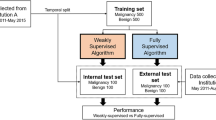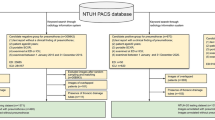Abstract
Purpose
To address the difficulties of M-mode ultrasound images classification in pneumothorax diagnosis and the shortcomings of existing neural network algorithms in this field, we proposed an M-mode ultrasound images classification model based on Disturbed Meta-Pseudo-Labels (D-MPL).
Methods
An M-mode ultrasound image augmentation system was designed to make the model more robust and generalizable. In D-MPL, teacher-generated pseudo-labeling was first taught to students through a soft mask, and additional disturbance data were added to the teacher network. As the loss of the teacher network continues to decline, disturbance data were injected to improve the generalization of the model to cope with image differences across patients in clinical settings.
Results
We compared the proposed model with four commonly used models, including MPL, EfficientnetB2, Inception V3, and Resnet101, in order to confirm its efficacy. Our model has an average specificity of 98.28%, sensitivity of 98.22%, F1-score of 98.23%, and AUC of 98.10%, according to the experiment findings, and its comprehensive performance is better than the above four models.
Conclusion
The results demonstrated our model's superiority over the competition and its greater. The model proposed in this study is expected to assist doctors in the diagnosis of pneumothorax as an auxiliary mean.






Similar content being viewed by others
References
Duclos G, Bobbia X, Markarian T, Muller L, Cheyssac C, Castillon S, Ressequier N, Boussuques A, Volpicelli G, Leone M, Zieleskiewicz L (2019) Speckle tracking quantification of lung sliding for the diagnosis of pneumothorax: a multicentric observational study. Intensive Care Med 45(9):1212–8. https://doi.org/10.1007/s00134-019-05710-1
Weissman J, Agrawal R (2021) Dramatic complication of pneumothorax treatment requiring lifesaving open-heart surgery. Radiol Case Rep 16:500–3
Lichtenstein DA (2015) BLUE-protocol and FALLS-protocol: two applications of lung ultrasound in the critically ill. Chest 147(6):1659–1670
Rovida S, Orso D, Naeem S, Vetrugno L, Volpicelli G (2022) Lung ultrasound in blunt chest trauma: a clinical review. Ultrasound 30(1):72–79
Bouhemad B, Zhang M, Lu Q, Rouby J-J (2007) Clinical review: Bedside lung ultrasound in critical care practice. Crit Care 11(1):205
Alrajhi K, Woo MY, Vaillancourt C (2012) Test characteristics of ultrasonography for the detection of pneumothorax: a systematic review and meta-analysis. Chest 141(3):703–708
Santos-Silva J, Lichtenstein D, Tuinman PR, Elbers PW (2019) The lung point, still a sign specific to pneumothorax. Intensive Care Med 45(9):1327–1328
Lindsey T, Lee R, Grisell R, Vega S, and Veazey S (2018) Automated pneumothorax diagnosis using deep neural networks. In: Iberoamerican congress on pattern recognition (pp 723–731). Springer, Cham. Available from: https://doi.org/10.1007/978-3-030-13469-3_84.
Mehanian C, Kulhare S, Millin R, Zheng X, Gregory C, Zhu MSS (2019) Deep learning-based pneumothorax detection in ultrasound videos. In: Smart ultrasound imaging and perinatal, preterm and paediatric image analysis (pp 74–82). Springer, Cham. doi.org/https://doi.org/10.1007/978-3-030-32875-7_9.
Lundervold AS, Lundervold A (2019) An overview of deep learning in medical imaging focusing on MRI. Z Med Phys 29(2):102–27
Singh A (2021) Clda: contrastive learning for semi-supervised domain adaptation. Adv Neural Inform Process Syst 34:5089–5101
Ding R, Zhou Y, Xu J, Xie Y, Liang Q, Ren H, Wang Y, Chen Y, Wang L, Huang M (2021) Semi-supervised optimal transport with self-paced ensemble for cross-hospital sepsis early detection. arXiv preprint arXiv:2106.10352.
Wang JX (2021) Meta-learning in natural and artificial intelligence. Curr Opin Behav Sci 38:90–5
Peng H (2021) A Brief Summary of Interactions Between Meta-Learning and Self-Supervised Learning. arXiv preprint arXiv:2103.00845.
Pham H, Dai Z, Xie Q, and Le QV (2021) Meta pseudo labels. In: Proceedings of the IEEE/CVF conference on computer vision and pattern recognition (pp 11557–11568).
Yang W, Zhou Y, Hu M, Wu D, Zheng JX, Wang H, Guo S. (2021) Gain without Pain: offsetting DP-injected Nosies Stealthily in Cross-device Federated Learning. IEEE Internet of Things Journal.
Lichtenstein D, Mezière G, Biderman P, Gepner A (2000) The “lung point”: an ultrasound sign specific to pneumothorax. Intensive Care Med 26(10):1434–1440
Lenoir V, Kohler R, Montet X (2013) The empty azygos fissure. J Radiol Case Rep 7(4):10–15
Oizumi H, Kato H, Endoh M, Inoue T, Watarai H, Sadahiro M (2014) Slip knot bronchial ligation method for thoracoscopic lung segmentectomy. Ann Thorac Surg. 97(4):1456–8
Zhang K, Zuo W, Chen Y, Meng D, Zhang L (2017) Beyond a Gaussian denoiser: residual learning of deep CNN for image denoising. IEEE Trans Image Process 26(7):3142–3155
Lang M, Guo H, Odegard JE, Burrus CS, Wells RO (1996) Noise reduction using an undecimated discrete wavelet transform. IEEE Signal Process Lett 3(1):10–12
Tay MKC, Laugier C (2008) Modelling Smooth Paths Using Gaussian Processes. In: Laugier C, Siegwart R (eds) Field and Service Robotics. Springer Berlin Heidelberg, Berlin, Heidelberg, pp 381–390. https://doi.org/10.1007/978-3-540-75404-6_36
Stach S, Giurfa M (2001) How honeybees generalize visual patterns to their mirror image and left–right transformation. Anim Behav 62(5):981–91
Wang M, Luo C, Hong R, Tang J, Feng J (2016) Beyond object proposals: random crop pooling for multi-label image recognition. IEEE Trans Image Process 25(12):5678–5688
Smilkov D, Thorat N, Kim B, Viégas F, and Wattenberg M (2017). Smoothgrad: removing noise by adding noise. arXiv preprint arXiv:1706.03825.
Buades A, Coll B, Morel JM (2005) A review of image denoising algorithms, with a new one. Multiscale Model Simul 4(2):490–530
Gelman A, Carpenter B (2020) Bayesian analysis of tests with unknown specificity and sensitivity. J Roy Stat Soc: Ser C (Appl Stat) 69(5):1269–1283
Fawcett T (2006) An introduction to ROC analysis. Pattern Recogn Lett 27(8):861–874
Tan M, and Le Q (2019) Efficientnet: rethinking model scaling for convolutional neural networks. In: International conference on machine learning (pp 6105–6114). PMLR.
Szegedy C, Vanhoucke V, Ioffe S, Shlens J, and Wojna Z (2016) Rethinking the inception architecture for computer vision. In: Proceedings of the IEEE conference on computer vision and pattern recognition (pp 2818–2826).
He K, Zhang X, Ren S, and Sun J (2016) Deep residual learning for image recognition. In Proceedings of the IEEE conference on computer vision and pattern recognition (pp 770–778).
Acknowledgements
M-mode ultrasound image data used in this study are all from the Third Affiliated Hospital of Soochow University.
Author information
Authors and Affiliations
Corresponding authors
Ethics declarations
Conflict of interest
The authors declare that they have no conflict of interest.
Ethical approval
All procedures performed in studies involving human participants were in accordance with the ethical standards of the institutional and/or national research committee and with the 1964 Declaration of Helsinki and its later amendments or comparable ethical standards.
Informed consent
Informed consent was obtained from all participants included in the study.
Additional information
Publisher's Note
Springer Nature remains neutral with regard to jurisdictional claims in published maps and institutional affiliations.
Rights and permissions
Springer Nature or its licensor (e.g. a society or other partner) holds exclusive rights to this article under a publishing agreement with the author(s) or other rightsholder(s); author self-archiving of the accepted manuscript version of this article is solely governed by the terms of such publishing agreement and applicable law.
About this article
Cite this article
Zhang, T., Yan, S., Wei, G. et al. Automatic diagnosis of pneumothorax with M-mode ultrasound images based on D-MPL. Int J CARS 18, 303–312 (2023). https://doi.org/10.1007/s11548-022-02765-2
Received:
Accepted:
Published:
Issue Date:
DOI: https://doi.org/10.1007/s11548-022-02765-2




